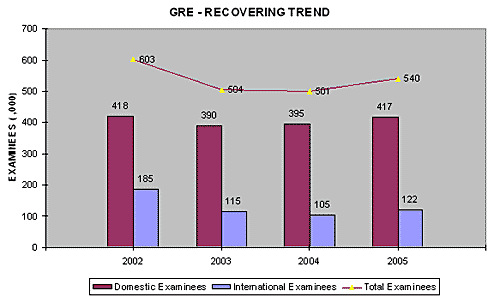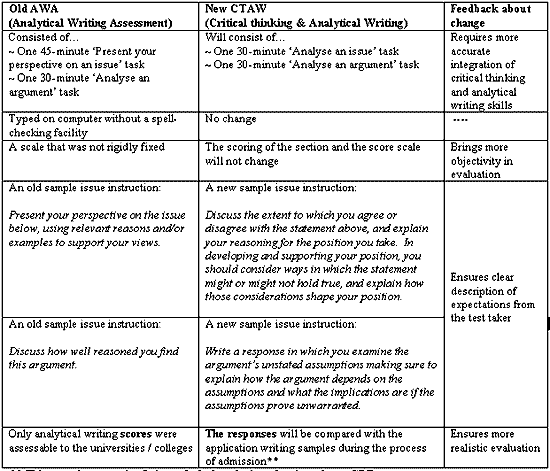|
|
| Help | |
| You are here: Rediff Home » India » Get Ahead » Study Abroad » Going to the US |
|
| |||||||||||||||||||||||
|
| |||||||||||||||||||||||
The ETS is changing the design of the Graduate Record Exam in order to provide students a friendlier format. The company is seeking to raise the volume of tests administered from below 6,00,000 to above 34,00,000 per annum; the current design makes this goal implausible. The figure below, provided by ETS, demonstrates the marked decrease in test-takers since 2002.

**Data Source: ETS
Analysis: TCY
While some have greeted the change with scepticism and alarm, most have accepted the new design with a positive attitude. In order to increase understanding of the new format, this article examines changes to the Quantitative Reasoning and Analytical Writing measures.
New Quantitative Reasoning measure
The new Quantitative section of the GRE demands better reasoning methods from aspirants. The purpose is to test students in the same manner as they will be tested in graduate school. It contains two 40-minutes sections; ETS has not yet clarified if the sections are identical in all respects.
It is expected that one quantitative section will feature 25 questions to be answered in 40 minutes. If true, the average time available per question will come down from 2.02 minutes to 1.6 minutes. This point, coupled with the higher number of reasoning-based questions, will make the test more challenging for students. Let us examine the breakdown of question types:

++Click here to see the sample questions on Quantitative Reasoning given by ETS.
More samples
New Analytical Writing measure
The new name of this measure -- Critical thinking and analytical writing -- more accurately describes the skills being tested. The GRE has always aimed to assess both critical thinking and analytical writing; the new design integrates both aspects more clearly than the current format. This diagram displays the change:

** This came into practice 5-6 months before the introduction of new GRE
++Click here to see the sample CTAW topics given by ETS
Review
1. A new linear (hopefully trickier) GRE replaces old-adaptive (perceived tough).
2. The old GRE score DOES NOT lose its validity. A scale is available for those who have already taken the old GRE.
3. The new GRE has become more reasoning-savvy. Reliance on abstract vocabulary has been reduced.
4. The aim is to take the mean verbal GRE scores up from 439/800 per the old format to 150/170 per the new one.
5. In the Quantitative section, there will be minimal focus on higher geometry and increased focus on real life problems, data interpretation and quantitative reasoning. Test-takers can reduce time on computation and devote more time and attention on analysis.
6. The name of the analytical writing section has been changed to make it easier for the students to understand the purpose of the section. Critical thinking & Analytical writing (CTAW) responses will be available to universities/institutes for appraisal vis-�-vis the strength of the applicant's write-up in the SOP. This will certainly cause concern for students who hitherto sought professional help to make their SOPs look impressive; the CTAW must now be equally impressive.
7. Though the revised GRE may appear easier than the old GRE, we feel it has become more difficult due to the following reasons:
- Increased expectations on Verbal score.
- Increased expectations on CTAW score.
- Need to reduce score clustering near the top in Quantitative sections.
- Question types allowing/requiring more than one correct answer.
-- The author is Centre Head at Top Careers and You, an organisation that prepares candidates for leading competitive examinations like CAT, GRE and GMAT.
|
|
| © 2007 Rediff.com India Limited. All Rights Reserved. Disclaimer | Feedback |